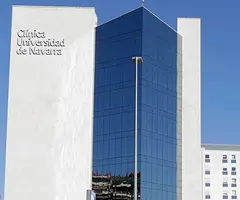Renal lithiasis or kidney stones
"In the Clinica we have all the existing minimally invasive treatments to solve renal lithiasis".
DR. FERNANDO RAMÓN DE FATA CHILLÓN
SPECIALIST. UROLOGY DEPARTMENT

What is renal lithiasis?
Renal lithiasis is a chronic disease characterised by the formation of stones in the urinary tract, the treatment of which is not based solely on medical or surgical measures.
Most patients have some disorder in the absorption, metabolism or excretion of stone components, stone inhibitors or urine pH.
Recent studies indicate that 60% of patients who have had a stone will have another stone within 10 years, 35% within 5 years and 15% within 1 year of the first episode.
In the Urology Department we have the latest technology for immediate diagnosis and all the minimally invasive treatment options currently available to eliminate kidney stones. In addition, we collaborate with the Nephrology Service to perform a metabolic study to determine the cause and thus, establish preventive measures.

Symptoms of renal lithiasis
Algunos de los síntomas más habituales de la litiasis renal son dolor, hematuria y/o infecciones de orina.
The clinical presentation of kidney stones varies depending on the size, location and composition of the stones.
Nephritic colic
Very intense pain caused by the obstruction of urine outflow from the kidney, which appears in the lumbar area and radiates towards the abdomen and genitals. It is an intermittent, unsettling pain, with nausea, vomiting and sweating. Fever may occur.
Haematuria
This is the appearance of blood in the urine. It may or may not be visible to the naked eye. It is caused by the lesions produced by the stone as it passes through the urinary tract.
Urine infections
Kidney stones can be a cause or a consequence of frequent urine infections.
Do you have any of these symptoms?
If you suspect that you have any of the above symptoms,
you should consult a medical specialist for a diagnosis.
What are the causes of kidney stones?
In recent decades, substantial progress has been made in the understanding of the pathophysiological mechanisms responsible for calculi disease, enabling the development of effective and rational programmes for both treatment and prevention of recurrence.
With current knowledge, the chain of events leading to stone formation can be altered by changing some environmental factors, such as the diet (eating habits) of patients, who can be given comprehensive guidelines for each specific type of stone disease.
Most patients have some disorder in the absorption, metabolism or excretion of stone components (calcium, oxalate, uric acid), inhibitors of stone formation (citrate and magnesium) or alterations in urine pH.
Who can suffer from kidney stones?
Kidney stones (97% of stones in industrialised countries) are the third most common condition of the urinary system. For a life expectancy of 70 years, the probability of developing a stone is estimated at 15% (5% in women, 12% in men). In terms of clinical manifestations, men are more symptomatic than women, with 3 men for every woman.
There is probably a lithiasic inheritance, which is difficult to prove due to the coexistence of numerous extrinsic factors, mainly dietary and environmental. Although there is no age, country or ethnic group protected against this common disease, the peak incidence is between 40 and 50 years of age, in the warmer months (June to September) and in people with professions involving intense physical activity, living in humid environments or exposed to high temperatures.
Recent studies indicate that 60% of patients who have had one stone will have another within 10 years, 35% within 5 years and 15% within 1 year of the first episode.
How is kidney stones diagnosed?
The diagnosis of kidney stones (renal lithiasis) is based on clinical symptoms and urine analysis. The location, size, and impact of the stone are assessed through imaging studies.
Detailed metabolic studies are performed, including 24-hour urine collection to evaluate the excretion of calcium, oxalate, citrate, and other risk factors. In addition, renal tubular abnormalities that may predispose to stone formation are also assessed.
Depending on the composition of the stones and other factors, a metabolic-mineral evaluation should be performed to rule out recurrence of the disease.
How is kidney stones treated?
80% of stones in the ureter pass spontaneously within 3-4 weeks, depending on their size and location. Any stone not expelled within 1-2 months usually requires therapeutic action.
Most stones can now be removed by minimally invasive procedures:
- Endourological treatment (endoscopic stone removal using semi-rigid or flexible ureteroscopy) and minimally invasive percutaneous percutaneous nephrolithotomy (percutaneous endoscopic access and laser lithotripsy to remove larger stones).
- Extracorporeal shock wave lithotripsy, which involves breaking stones into small fragments that can be more easily expelled.
The aim of medical treatment of urolithiasis is to prevent recurrence, especially in young patients under 40 years of age, with multiple and bilateral urolithiasis or recurrent disease.
Several general dietary measures may allow better control of stone disease, such as increasing fluid intake, preferably water (the first and simplest measure to prevent stone disease), following a diet of no more than 2,000 Kcal, low salt, limiting animal proteins, sugars and alcohol.
Through the High Resolution Lithiasis Program we offer an immediate diagnosis and make available all the minimally invasive treatment options currently available to eliminate lithiasis within a maximum of 1 week:
- Extracorporeal shock wave lithotripsy.
- Semi-rigid ureteroscopy.
- Flexible digital ureteroscopy.
- Endoscopic treatment of bilateral renal and/or ureteral lithiasis.
- Percutaneous nephrolithotomy: Percutaneous nephrolithotomy system of reduced caliber minimally invasive, which allows to treat large renal lithiasis, without the need for transfusion and without postoperative nephrostomy with an incision < 1 cm.
- Endoscopic lithotripsy with Holmium laser (Lumenis 120W)
- Combined endoscopic approach through flexible ureteroscopy and percutaneous mini-nephrolithotomy.
Where do we treat it?
IN NAVARRE AND MADRID
The Department of Urology
of the Clínica Universidad de Navarra
The Department of Urology of the University of Navarra Clinic offers the patient a medical team, composed of first-rate professionals, and state-of-the-art diagnostic and therapeutic means such as the Da Vinci® robotic surgery.
The Department of Urology possesses the certificate of accreditation of the European Board of Urology, a reinforcement of the excellence of the service at the level of care, teaching and research, which in Spain only three hospital centers possess.
Diseases we treat:
- Prostate Cancer
- Kidney Cancer
- Bladder Cancer
- Testicular Cancer
- Benign prostatic hyperplasia
- Urinary Incontinence
- Renal Lithiasis
- Genitourinary Prolapses
- Pediatric Urology

Why at the Clinica?
- A team of top-level professionals trained in international centers.
- State-of-the-art technology for diagnosis and treatment.
- In 24-48 hours you can start the most appropriate treatment.














